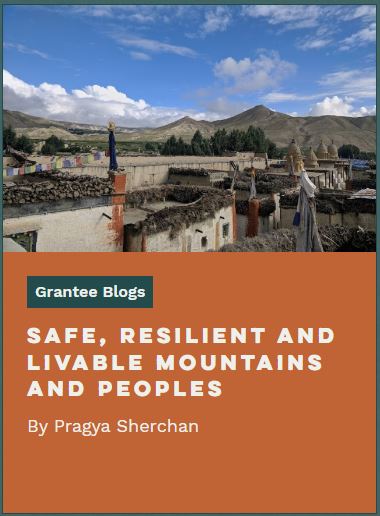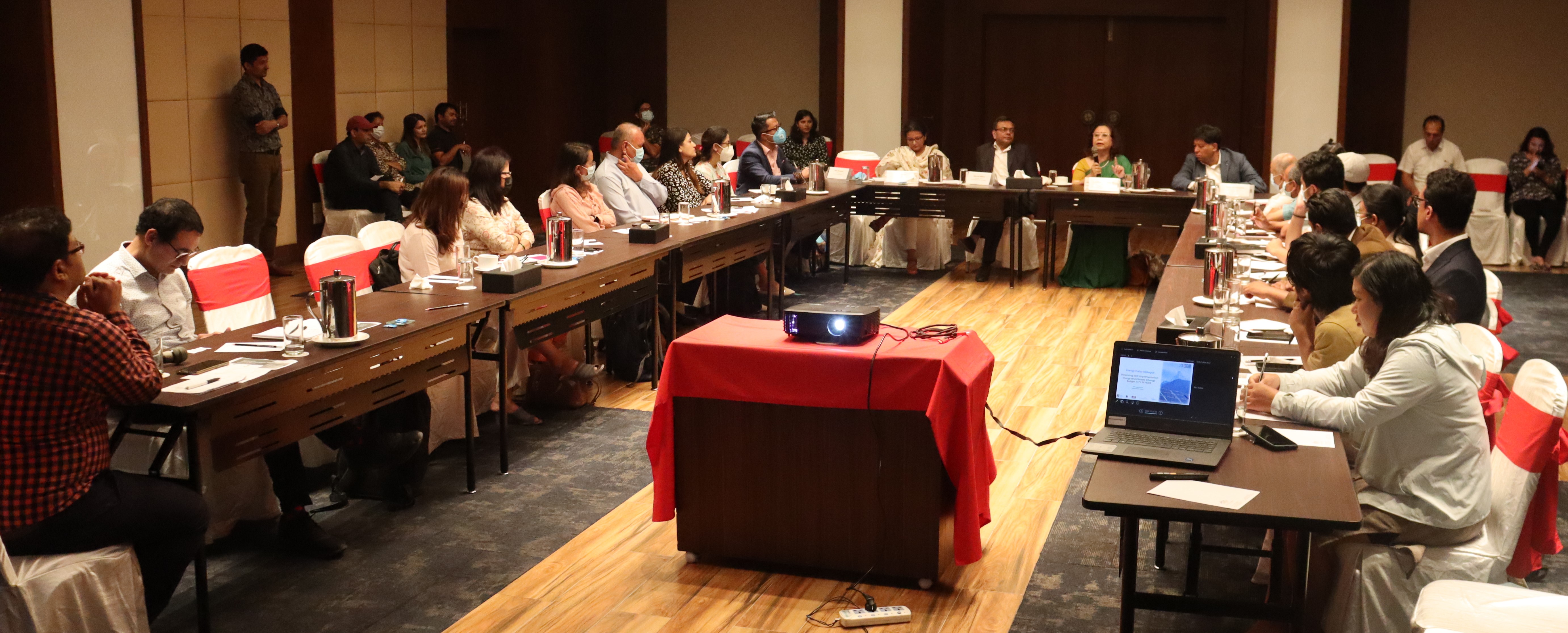
PRC Article
Safe, Resilient and Livable Mountains and Peoples
Mountain is not only about geography. It’s also about the mountain community, people, culture, tradition, food, livelihoods, biodiversity and ecosystems that are directly dependent to Mountain phenomena. Due to the virtue of elevation, mountains on earth are hotspots of climate impacts. Pragya Sherchan
To read: https://www.jwhinitiative.org/blog-news/safe-resilient-and-livable-mountains-and-peoples
Becoming a climate negotiator
To read full blog: https://www.jwhinitiative.org/blog-news/becoming-a-climate-negotiator
Women in Organic Movement: A Solution to Climate Crisis
Pragya Sherchan
In a project reflection meeting women groups proposed an exchange visit among themselves to cross learn from their works. Initially, I was not fully convinced with the idea. I fear that it will be a recreation activity rather than a learning event. Lately I thanked the women groups for proposing the exchange visit. The woman groups not only learned but are motivate to replicate the learning in their own palikas.
I joined Srijansheel Mahila Samaj Nepal team, a woman group in Tarakeshwor municipality, to Nala, Banepa municipality and observe the works of Mahila Jagaran Samuha, a women group in Banepa municipality. Mahila Jagaran Samuha is leading an organic movement in leadership of Nirmala Shrestha who herself is a cancer survivor of excessive use of chemical fertilizer. In Nala, we observed making of organic fertilizers eg. Effective Microorganism (EM) and Bokashi. These fertilizers are used for composting biodegradable waste generated from kitchen and apply in rooftop farming. We learned that managing biodegradable waste reduce methane emission. Mahila Jagaran Samuha is also producing organic local products such as candies, jam, juice, pickles, titaura (mix of sourness, sweetness and spiciness in the form of candy) and ketchup from local fruits and vegetables manufactured by them. This organic movement lead by women group is empowering fellow women with skill, knowledge and employment and also contribute to addressing climate crisis.
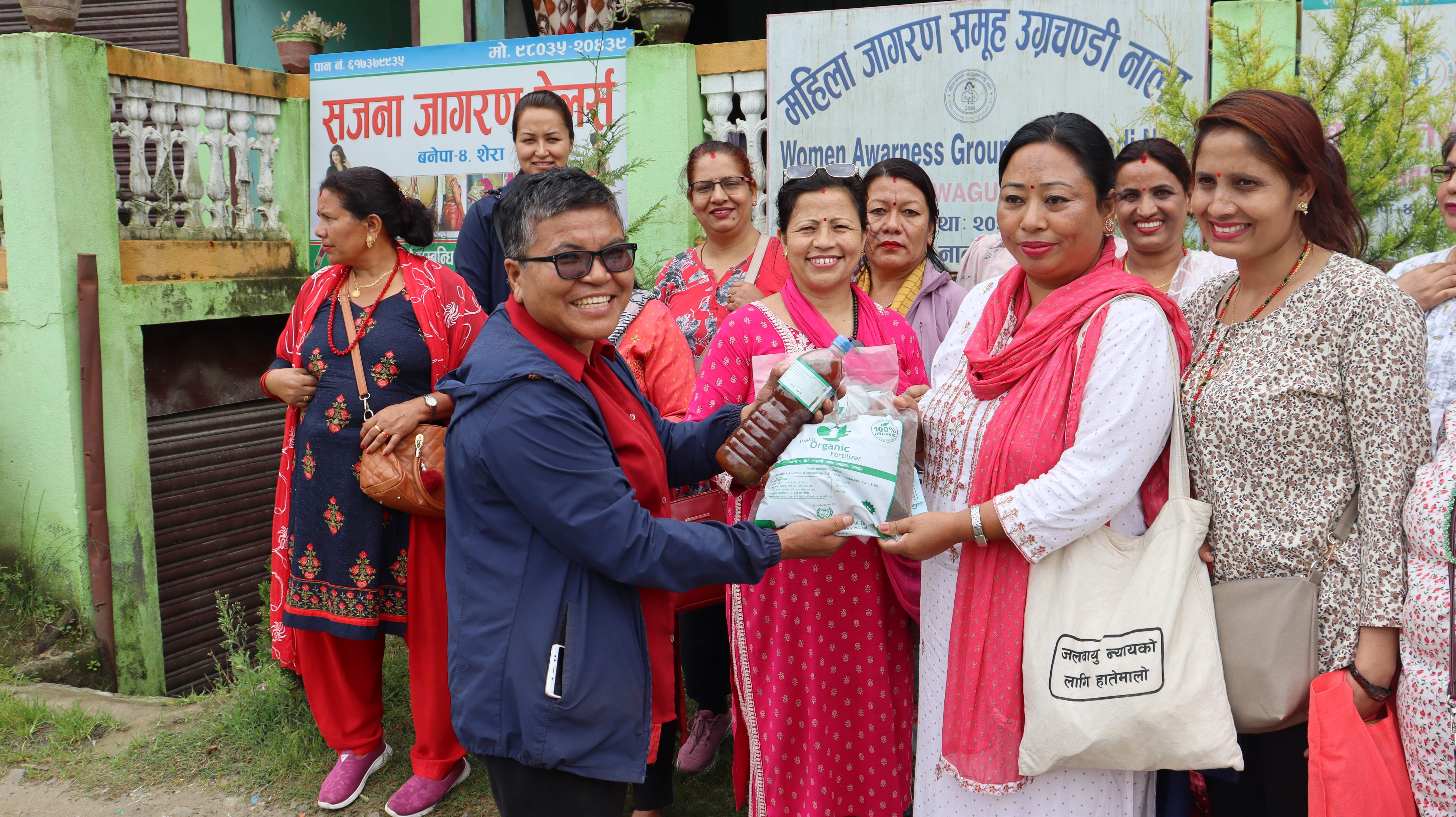
Ms. Susma Regmi, Chairperson, Srijansheel Mahila Samaj Nepal expressed gratitude to Mahila Jagara Samuha and PRC for the opportunity to learn on producing organic fertilizers from kitchen waste. In Tarakeshwor municipality (near to Kathmandu), we do not have arable land as in Nala. However, we can do rooftop farming. Besides solid waste (plastic, paper, cloth etc) now we have the idea to manage our kitchen waste, she added. Her group has already approached the municipality to work on rooftop farming and organic fertilizers from kitchen waste.
In reciprocity Mahila Jagaran Samuha learned reuse and recycling of solid waste in their visit to Srijansheel Mahila Samaj Nepal. In Tarakeshwor municipality, the women group collects solid waste from their member houses and segregated plastic and metals are sold to a local recycler. Cloths are recycled to develop cushions and mattress and sell them in Montessori schools. The group is earning income and also contributing to waste management in the municipality.
Ms. Nirmala Shrestha, Chairperson, Mahila Jagaran Samuha said that plastic and other types of solid waste is increasing in her locality. Now she had an idea on recycle and reusing solid waste. Her group is working to replicate the work in their place.
Sahayatra Nepal visited India’s State of Sikkim and learned from Hon. Prem Singh Tamang, Chief Minister and Hon. Loknath Sharma, State Minister and Mr. Kunga Samdup Bhutia, Joint Director, Agriculture Department on “Farming is Future and Future is Farming” movement in Sikkim. They shared that in the first three years organic farming produce less but in the later years the production is higher than the chemical fertilizer. The Chief Minister awarded the group with Indian Rupees 50,000 (approximately USD 600) to initiate organic movement in Ilam municipality. After the visit, Hem Kumari Siwa, Chairperson, Sahayatra Nepal said they will engage to replicate organic farming movement in Ilam municipality. A team of Sikkim government made a return visit to Ilam and interacted with the municipal team. This has further support their movement.
I am amazed by learning made by the women groups and actions that they had taken after the field visits. The passionate and dedicated women groups are now in organic movement. I am happy that I was proved wrong. These visits are made through ‘Civil society engagement for gender-just climate solutions and actions in Nepal’ project supported by Global Alliance for Green and Gender Action (GAGGA).
Enhancing NDC Implementation through the National Budget
Bidhya Sharma Subedi and Pradeep Bhattarai
Nepal’s Nationally Determined Contribution (NDC) has emphasized the generation and consumption of clean energy as a key to achieving the target of net zero emission by 2045. It has targeted to generate 15,000 MW of clean energy by 2030, of which 5-10% will be from mini and micro hydropower, solar, wind, and bio-energy. Likewise, NDC has set a target to increase the sales of electric vehicles to 90% of all private passenger vehicles, including two-wheelers, and 60% of all four-wheeler public passenger vehicle sales by 2030. Moreover, the NDC has targeted to use of electric stoves as the primary cooking mode of 25% of households by 2030. The estimated cost of achieving the conditional mitigation targets is estimated at USD 25 billion while achieving the unconditional targets is estimated at USD 3.4 billion.
The government of Nepal has planned to add 715 MW of electricity to the national grid and increase annual per capita electricity consumption to 400 KW per hour. It also plans to provide electricity access to 100% of the population in the next two years. Nepali Rupees 75.10 billion (approximately USD 0.75 billion) has been allocated for electricity generation, transmission line expansion, and increased electricity use in the current fiscal year 2022/23. These plans are aligned with and contribute to achieving the above-mentioned NDC targets. However, the government needs to embrace an idea of an energy mix and scale up investment in renewable energy other than hydroelectricity.
This year, the government introduced the 'One House, One Electric Stove' campaign to substitute imported Liquefied Petroleum Gases (LPGs) with electric stoves. This is an important policy shift that not only expands the utilization of clean energy but also supports macroeconomic stability. An import of LPG has increased exponentially in the last decade. The Department of Customs states, The Last fiscal year showed import of 360.03 million kgs of LPG worth of Rs. 40.64 billion being imported.
Nepal has done a lot on electric cooking as shared by Pooja Sharma, Practical Action Nepal in the discussion program on “Energy Policy Dialogue on Implementing NDC targets: Energy and Climate Change in Budget of FY 2022/23” organized on August 11, 2022, by Prakriti Resources Centre and WWF Nepal. She highlighted on awareness to users, especially women as many are facing problems in using electric stoves. The government should develop policies to check the quality of stoves and maintenance services. Reliable and affordable electricity supply is a prerequisite in scaling up the use of electric appliances, she added.
The participants of the discussion program opined that the federal budget has rightly prioritized e-cooking, e-vehicles, and the generation of clean energy. These will support Nepal to progress toward the pathway as directed in the NDC. The following suggestions were made for furthering the progress made in the energy sector.
- Invest in the development of infrastructure required for energy use in the country, and awareness among the citizens.
- Scale up investment on renewable energy sources to promote the energy mix.
- Develop a detailed plan to ensure the effective implementation of the program
- Continuation of progressive programs in the future years.
- Track the achievements made against the NDC targets over the years.
In summary, NDC and the federal budget has set the right direction for Nepal to progress towards an energy transition with a focus on the generation and consumption of clean energy sources. The government needs to continue and scale up the investment in the energy sector to make significant progress on achieving the energy-related targets in NDC.
Scaling up climate adaptation actions through innovative financing instruments: A case of Nepal.
Pragya Sherchan
September, 2022
Innovative financing with regard to climate adaptation is an emerging concept globally. Innovative financial instruments for adaptation are defined as innovative approaches and mechanisms to acquire, structure, govern, and allocate financial resources. These instruments can include three alterations to traditional finance:
- Acquisition of new financial resources and blending with traditional resources to finance adaptation actions.
- Enhanced efficiency in raising and distributing financial resources.
- Enhanced effectiveness of investments.
These innovative instruments are rarely used in developing countries like Nepal. Prakriti Resources Centre (PRC) in partnership with International Institute for Sustainable Development (IISD) analysed the project ‘Public and private sector collaboration to enhance food security through promoting climate resilient agriculture’ to draw learning on innovative financial mechanisms that can be used to scale up finance for climate adaptation in developing countries. The project was initiated by International Financial Corporation (IFC) and was implemented from 2013 to 2019. It provides examples of different financing instruments used to increase farmers’ adaptive capacity by minimizing the risk of crop losses from climate hazards.
The project received USD 2 million as a grant and USD 3.6 million in concessional lending through Climate Investment Fund – Pilot Programme on Climate Resilience (CIF-PPCR). Canada Climate Change Programme and International Financial Corporation (IFC) invested an additional USD 0.49 million in the project. Three agribusiness firms, namely Golchha Group, Sharda Group and Probiotech – Nimbus Group collectively invested around USD 0.3 million in cash and kind. The grant amount was utilized in building capacity of three firms and farmers, and piloting climate resilient practices and technologies. Business Oxygen (BO2) Private Limited, a private equity fund, received USD 3.6 million concessional loan to finance small and medium enterprises to invest in climate smart businesses.
Gandaki Urja Pvt. Ltd. is one of the clienteles of BO2 Pvt. Ltd. that produce biogas and organic fertilizers from cow/buffalo dung, pig manure, poultry litter and vegetable/agricultural wastes. BO2 Pvt. Ltd. invested USD 0.5 million. Besides equity finance, IFC provided a grant of USD 25,000 to the firm for technical assistance, which was utilized in marketing, building accounting capacity and enhancing the knowledge gap on understanding the fertilizer value chain and markets. According to Mr. Kushal Gurung, a proprietor of Gandaki Urja, equity financing has three clear advantages over bank lending. First, equity financing does not require collateral, unlike a bank loan that demands it. Bank loan also incurs service charges, property valuation, insurance and other costs. Second, risks and benefits in the business are shared equally between the SME and BO2. Third, IFC and BO2-led equity financing also provides technical assistance support to SMEs to increase technical capacity and address knowledge gaps in operating the business.
The case study generated learning on appropriateness of innovative financing instruments on scaling up adaptation financing. Adaptation projects generally have a low return on investment and may not be of interest for private investment. Innovative financing instruments like equity financing requires project with good return on investment and are more suitable for mitigation projects with adaptation co-benefits. Climate finance offers opportunities to private sector firms to start up new businesses/enterprises by developing unique products, identifying local customers’ demand, capitalizing the benefit of going green, and finding innovative ways to reduce costs while going green and natural.
Scaled up and reformed MDB financing for climate adaptation – the need of the day
Prabin Man Singh
August, 2022
Nepal is one of the most vulnerable countries to climate change. The country needs to invest a large sum of money to protect its people from adverse impacts of climate change. Estimated budget of National Adaptation Plan (NAP) to finance priority projects till 2050 stands at a whopping USD 45.9 billion. Similarly, USD 25 billion is required to achieve conditional mitigation targets of second Nationally Determined Contribution (NDC) of Nepal. Approximately USD 2.36 billion per annum is required to achieve mitigation and adaptation targets by 2050. The government of Nepal had allocated approximately USD 0.5 billion annually for climate actions during the last 10 years. Nepal’s present budgetary allocation for climate actions is only one-fifth of what is needed. Multilateral Development Banks (MDBs) can play a significant role in meeting the deficit.
Prakriti Resources Centre (PRC) and International Institute for Sustainable Development (IISD) conducted a study on the investment of the World Bank and Asian Development Bank in climate adaptation actions in Nepal between 2013 and 2020. The World Bank had funded 56 projects with a total investment of USD 4.59 billion. Nine out of the 56 projects had adaptation co-benefits, while eight others had both adaptation and mitigation co-benefits. Total adaptation-related financing in Nepal amounted to USD 1.20 billion (26%) from 2013 to 2020, compared to USD 0.45 billion (10%) with mitigation co-benefits. Similarly, nine out of 32 ADB projects in Nepal between 2013 and 2020 had financed only for adaptation co-benefits, while seven projects’ financing had aimed at both adaptation and mitigation co-benefits. The total adaptation-related financing amounted to USD 0.32 billion between 2013 and 2020. 10.48% of all ADB financial commitments during the period were for adaptation, compared with 22% for mitigation.
The study also determined that 44.64% (25 out of 56) of World Bank projects that were approved for funding from 2013 to 2020 in Nepal were screened for climate risks. All ADB projects in Nepal were screened for climate risks from 2013 to 2020. Climate risk assessments were undertaken for most large infrastructure projects financed by the banks during the period, which identified the expected climate impacts on the project and designed actions to address those impacts. The banks used their own tools and methods to undertake climate risk screening. Nepal’s climate vulnerability and risks assessments are largely overlooked by the banks.
Investments of the banks on climate adaptation projects marked an increase in 2013 to 2020. However, a majority of the investments are for climate proofing the sectoral projects, mainly on infrastructure. Each bank had funded only one dedicated climate adaptation project. The World Bank and Asian Development Bank’s Country Strategy documents have listed agriculture, water resources and disaster risk reduction and management as priority sectors for climate adaptation in Nepal. Only 13% of World Bank’s adaptation financing is allocated for projects related to the three priority sectors. ADB had financed 36% of its total adaptation financing to projects related to the priority sectors.
Climate risk assessment is conducted in the project development phase and it largely takes place at the (MDB) headquarters. The level of engagement of the country teams as well as the line ministries and local stakeholders in the risk assessment is pretty low.
MDBs financing on climate adaptation is increasing but this finance is mainly to climate proof their investments. MDBs need to increase finance on adaptation that directly benefits the poor and vulnerable communities adversely affected by climate change. Concessional lending is the most common financial instruments used by MDBs for financing adaptation projects. The banks need to scale up grant to support developing countries for enhancing their adaptation efforts. MDBs need to align their financing decision with the national priorities identified in National Adaptation Plan and Nationally Determined Contributions.
Engaging MDBs in Financing the Government’s Adaptation Priorities
Raju Pandit Chhetri
July, 2022
Nepal requires scaled-up finance to achieve the priority adaptation actions set out in its 2021 National Adaptation Plan (NAP) and 2020 Nationally Determined Contribution. Nepal already mobilises substantial domestic resources from the government’s fiscal budget to address increasing climate-induced disasters such as landslides, floods, and droughts. Despite the large volumes of national finance for adaptation, Nepal needs to attract increased volumes of international finance that supports nationally defined adaptation priorities and addresses development and climate adaptation priorities in an integrated manner.
The Government of Nepal plans to develop a financing strategy for its NAP and NDC, and will need to engage development partners as part of participatory process to prepare this plan. The World Bank and Asian Development Bank (ADB) are long-standing development partners in Nepal that deliver substantial amounts of financing for adaptation. These MDBs can play a critical role to address the adaptation financing gap in Nepal, and moving forward, the government can encourage engagement with MDBs in a manner that contributes to financing adaptation in a positive manner. This can include:
- Engaging MDBs early in processes to develop financing strategies for adaptation to raise their awareness of priority actions, and to identify where MDB support can be used in a strategic manner to generate additional finance for adaptation.
- Providing consistent messaging on adaptation priorities to MDBs by ensuring that the Ministry of Finance that leads negotiations with MDBs and the Ministry of Forests and Environment that is the climate change focal ministry share a common understanding of the strategic adaptation priorities for grant funds and concessional loans provided through MDBs.
- Using strategic documents, such as the NDC, NAP, and climate vulnerability and risk assessments, to identify adaptation priorities, guide decisions, and inform the government-MDB dialogue. These are valuable sources of information that can inform MDB technical and financial analysis.
- Encouraging MDBs to consider national adaptation priorities as set out in the NAP and NDC in their country engagement strategies and programmes, and ensuring that all relevant MDB investments help build the adaptive capacity and resilience of the country.
- Using MDBs’ international expertise in mobilizing climate finance to scale up resources for the Nepal government to implement its adaptation priorities.
- Using the experience and expertise of MDBs to encourage private sector involvement in climate change adaptation, which is almost absent in Nepal.
- Using MDB analysis to inform adaptation plans, financing strategies, and cost estimates of adaptation actions. MDBs often have invested significant resources in analysis and project preparation that includes climate risk and vulnerability analysis, costing assessments and other analysis that can inform the policies and plans of government.
- Encouraging MDBs and other development partners to simplify their funding processes and conditions so that national institutions can easily comprehend these processes and better engage with MDBs through the MoF.
- Encouraging MDBs to provide and mobilize grant-based finance for non-revenue generating adaptation investments.
- Using an approach to financing adaptation action that is based on a system of integrating adaptation actions in the national development priorities. MDBs are critical partners in financing climate-resilient infrastructure.
- Working with MDBs to prepare and present bankable adaptation projects (being projects that comply with all the information required by a funding entity, and offer an expected return as repayment) that are informed by measurable and quantitative data of the implementation costs and benefits.
Nepal can encourage a more strategic approach to MDB financing that can help to scale up support for nationally defined adaptation priorities through increased volumes of finance, strategic use of grant funds to leverage other development partner and private sector investment, and ensuring that MDB programs address development and climate adaptation priorities in an integrated manner.
IPCC AR6 WG1: Science Need to Back by Political Actions
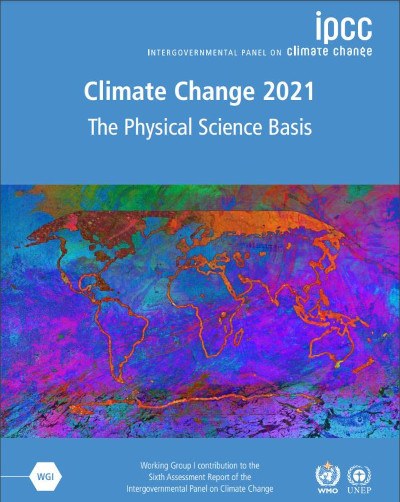
Pragya Sherchan
The UNFCCC COP 26 was concluded in November at Glasgow, Scotland. Every individual’s concern was: Will the global leaders take urgent and ambitious actions on greenhouse gases emission reduction as warned by the Inter-governmental Panel on Climate Change (IPCC)? However, the two- week long intense negotiation ended with adoption of watered down (a compromise and a hope) “Glasgow Climate Pact” from “Glasgow Climate Emergency Pact” and with the last minute change from coal ‘Phase-out‘ to ‘phase-down’.
Inter-governmental Panel on Climate Change (IPCC) has published Working Group I (WGI) report on Climate Change 2021: The Physical Science Basis as a part of the Sixth Assessment Report (AR6) in August 2021. The report unequivocally highlights “observed increases in well-mixed greenhouse gas (GHG) concentrations since around 1750 caused by human activities”. This has warmed the atmosphere, ocean and land, leading to widespread and rapid changes in the atmosphere, ocean, cryosphere and biosphere.
IPCC is the United Nations body created by the World Meteorological Organization (WMO) and the United Nations Environment Programme (UNEP) in 1988. It was created to provide policy makers with regular scientific assessments on the current state of knowledge on climate change, its natural, political and economic impacts and future risk and possible response options for adaptation and mitigation. Till date IPCC has had five assessment cycles and published five Assessment Reports. In 2007, the IPCC and Vice-President Al Gore of the United States of America were jointly awarded the Nobel Peace Prize to build up and disseminate greater knowledge on human-induced climate change via AR4. Likewise, the two authors- Syukuro Manabe and Klaus Hasselmann from IPCC have also got the 2021 Nobel Prize in Physics for research that advances understanding of complex physical system such as Earth’s Changing climate. Now, IPCC is in its sixth assessment cycle. The IPCC is divided into three Working Groups viz. Working Group I: deals with The Physical Science Basis of CC; Working Group II: deals with CC Impacts, Adaptation, and Vulnerability; and Working Group III: deals with the Mitigation of CC.
The AR 6 WG 1 report has made the following conclusions on global temperature projection and the impacts.
- It is indisputable that human activities are causing climate change making extreme climate events, including heatwaves, heavy rainfall, and droughts, more frequent and severe.
- The earth’s global surface temperature was 1.09˚C (≈ 1.1 ˚C) higher in the decade between 2011-2020 than compared to the pre-industrial period.
- Business as usual emission scenario temperature rise to 1.5 ˚C will be crossed in the next 20 years, and 2 ˚C by the middle of the century.
- Climate change is already affecting every region on Earth in multiple ways. The changes we experience will increase with further warming.
- Every additional 0.5 ˚C of warming will increase hot extremes, extreme precipitation, and drought as well as weaken the earth’s carbon sinks present in plants, soils, and the ocean.
- Snow melting is faster, glacier retreat and mass loss are unprecedented in at least 2000 years. Sea-level rise has tripled compared to 1901-1971.
- The frequency of occurring climate events is once in every 10 years in the pre-industrial period has increased to 2.8 times in the present context with 1˚C warmer and with the further increase in temperature from 1.5 ˚C, and 2 ˚C the frequency would be 4.1 times and 5.6 times.
- There is no going back from some changes in the climate system. However, some changes could be slowed and others could be stopped by limiting warming.
- Unless there are immediate, rapid, and large-scale reductions in GHGs emissions, limiting warming to 1.5˚C and even 2˚C will be beyond reach.
- To limit global warming, strong, rapid, and sustained reductions in CO2, methane, and other GHGs are necessary. This would not only reduce the consequences of climate change but also improve air quality.
The report also provides a thin chance to stop the negative climate trends by mid-century by stopping the use of fossil fuels and stopping deforestation. It has called upon the global community to take climate action immediately as there is no time for delay and no room for excuses.
The current greenhouse gases reduction commitment is highly insufficient to limit the global temperature rise to 1.5 ˚C. As the global carbon emission needs to reduce by 45% from the 2010 level in the next nine years and net-zero by 2050. But, ironically the world is heading towards 2.4˚C by the end of this century, based on the current NDC submitted by 194 countries. The developed nations continued to shirk their historical responsibilities, obstructing funding for Loss and Damage. The COP26 did not secure a stable climate but it set directions for future climate actions, with improvements.
Though the outcomes did not meet the expectations of countries like Nepal, still a least developed and vulnerable country to climate change must urge the high emitting countries to take ambitious and urgent targets for climate emergency to save the world. For this strong political will is crucial at the international, national, and local level. In Nepal, the local election is on the forefront, now it is time to make environment and climate change issues of the political manifesto to tackle the climate emergency.
Nepal’s Pathways to Decarbonizing the Transport System
Shovana Maharjan
Transport accounts for around one-fifth of global carbon dioxide (CO2) emissions. The World Resource Institute’s Climate Data Explorer provides data that in 2016, global CO2 emissions (including land use) were 36.7 billion tonnes CO2; emissions from transport were 7.9 billion tonnes CO2. Transport therefore accounted for 7.9 / 36.7 = 21% of global emissions. Almost all (95%) of the world’s transportation energy comes from petroleum-based fuels, largely gasoline and diesel. Globally, around one-third of carbon emissions is contributed by the transport sector in recent times. In Nepal also, transport-related emissions make up the second-largest energy-related carbon emission. Hence, the transport sector has become one of the significant contributors to the increase in urban air pollution, along with increased dependency on petroleum import, Nepal’s trade deficit, road fatalities, and growing socio-economic and public health costs.
The statistics of the Department of Customs shows that Nepal imported petrol, diesel, liquefied petroleum gas, aviation fuel, kerosene, fuel oil and lubricating oil worth NRs 214.48 billion (approximately 1.9 billion USD) in 2018-19. To address carbon emissions, urban air pollution, and the reliance on imported fossil fuels, Nepal needs to move to decarbonize its transport system. Electrifying the transport system is the key to transport decarbonization – in this electrification, renewable energy would play a significant role. Nepal has the opportunity to achieve its Sustainable Development Goals (SDGs) and climate commitments, strengthen the economy, and improve the quality of life by moving away from fossil fuel-dependent transport regimes, increasing energy security and prioritizing the most efficient mobility system with the electrification of the transport system.
The second or revised Nationally Determined Contribution (NDC) by Nepal was communicated to the United Nations Framework Convention on Climate Change (UNFCCC) in December 2020. By that, Nepal has committed to increasing the sales of all-electric private passenger vehicles including two-wheelers by 25% by 2025 and increasing the sales of all-electric four-wheeler public passenger vehicle sales by 20% by 2025. Similarly, by 2030, sales of all private passenger vehicles including two-wheelers will be increased by 90%, and that of all four-wheeler public passenger vehicles by 60%. The country has also committed to constructing 200 km of the electric rail network.
In order to meet these commitments, the Government of Nepal has included some special provisions for promoting e-vehicles in its budget for the financial year 2021/22. The government is planning to purchase a minimum of 100 electric vehicles and install 500 charging stations across the country with the involvement of the private sector. Also, the government has forwarded its plan to displace all light vehicles which are run with petrol by electric vehicles by 2031. Upon the conversion of petroleum-powered vehicles to electric ones, the government will be providing a discount on registration fees and road tax for five years for electric vehicles. It will be charging no excise duty and reduced custom tax for e-vehicles. The government has allocated about NRs. 10.03 billion for the railway development. While on paper, the policies and plans sound very good but the problem lies in their implementation. If real changes should happen, the policies and plans have to be implemented. For this, the government needs to analyze the current situation and take all the concerned stakeholders’ voices into consideration, without letting the documents gather dust awaiting implementation endlessly.
In this context, Prakriti Resources Centre (PRC) and WWF Nepal organized a webinar on “Nepal’s Pathways to Decarbonizing the Transport System” on 15 July 2021 to discuss the need for decarbonizing transport, opportunities, challenges, and the way forward. The discussion in the webinar centered around the current scenario of transport development, policies and plans, and Nepal’s efforts for promoting electric and sustainable transport and sharing international best practices that Nepal can learn from.
Mr. Prashant Khanal, Urban Mobility Expert and the lead presenter, shed light on different aspects related to the possibility of promoting e-mobility in Nepal. Between 2011 and 2016, he said, Nepal’s road-transport CO2 emissions grew by 113%, adding that Nepal is one of the top 10 countries where transport emissions are projected to see a sharp increase from 2010 to 2050. The country is experiencing a rapid growth of motor vehicles run by petroleum. He informed the participants that in the Kathmandu Valley alone, while the share of walking and cycling has sharply plummeted, that of private vehicles has increased significantly from 13% in 1991 to 30% in 2011, and the share of public transport has remained static. Given these circumstances he stressed the need for Nepal to embark on the path of decarbonizing its transport system. The transformation of our transportation should not be just about reducing emissions, it should also address inequality in mobility access, road safety, and the causes and effects of traffic congestion in order to create just mobility systems. Electrifying Nepal’s transport system leads to hugely increased electricity demand. Increasing the share of renewable energy (solar, biogas, wind) in the country’s energy mix is essential to meet the future electricity demand and make the energy system resilient.
Subscribing to the views of the lead presenter, Mr. Bhusan Tuladhar, Environment Expert in the Sajha Yatayat Board, described the promotion of e-mobility as the best option for decarbonization. He emphasized the need for promoting public e-transportation by discouraging the use of private vehicles. However, he said, the budget for the financial year 2021/22 has no provision that facilitates the promotion of public transportation. Speaking of the need to expedite systematic reformation combined with the assurance of return on the initial investment to attract the private sector, Mr. Tuladhar pointed out that domestic finance like from the pollution tax on petrol would be enough if the government sincerely plans to mobilize available resources in promoting public e-transportation.
Representing the private and financing sectors, Mr. Dinesh Dulal, Head of Energy Department in the NMB Bank Ltd. stressed the need for consistency in policies and practices and the need for minimizing the initial cost through subsidies to convince the private sector of the promotion of e-transportation. He also suggested that the government should formulate appropriate policies and develop an investment-friendly e-vehicle sector in which the financing institutions become confident to invest. Prof. Dr Rejina Maskey furthermore also highlighted the importance of converting public vehicles into electric ones as 35% of petroleum imports and emissions are occurring due to public vehicles.
Presenting a different perspective, Ms. Shristina Shrestha who is an Urban Planner, opined that while decarbonization focuses on aspects as city planning and urban design with more cycling lanes and walkways, it equally demands that social and gender considerations are taken into account in the process. Mr. Shyam Sundar Sapkota, Provincial Transport Operation and Management Board Member of the Bagmati Province informed the webinar participants that the provincial government is planning to gradually displace the petrol-based vehicles by 2031. In the budget of 2021/22, he said, the provincial government has announced its decision to promote a public-private partnership for the promotion of an electric mass transit system.
The webinar concluded the necessity of promoting the public e-vehicle as public vehicles are the major emitters. The private sector engagement in promoting public e-vehicles should be encouraged through favourable policies and fair incentives by the government. While expressing its commitment to achieving the ambitious targets in the NDC, the government is also trying to fulfill the commitments which are reflected in the new policies and provisions of the recently announced budget and provincial plans, too. Of equal importance are necessary infrastructure like charging stations, roads, quality assurance of the vehicles, and most important is the provision of an adequate, and reliable supply of energy through the energy mix approach.
Localizing climate actions a way to achieve Nationally Determined Contributions
Pragya Sherchan, Programme Officer
Prakriti Resources Centre (PRC)
“The Earth should not be a worse place after my life than it was when I was born here.” – Rob Stewart, a Canadian award-winning biologist, environmentalist, conservationist, photographer and filmmaker.
I picked up the quote because it nudged me into a brief indulgence in retrospection, and made me feel somewhat nostalgic too. My own little earth or my birthplace is already no longer what it used to be when I was a kid. This very thought or a kind of my own conclusion catapulted me to a vantage point from where I am seeing the awe-inspiring beauty of mother nature fading away fast, and her divine gifts losing the vibrancy of their lives.
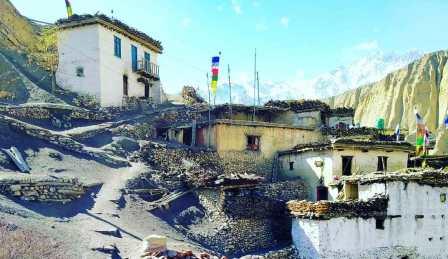
Photo: Traditional architectural houses of Mustang: Lupra Village
I belong to Mustang in Nepal, a beautiful mountainous region also known as the district beyond the mountains, desert of Nepal, forbidden kingdom, rain-shadow zone, etc. I grew up by playing in nature with nature. I found myself in complete harmony with the white and bright snow-capped mountains, and the snow and glacier-fed rivers and waterfalls. I’ve not yet forgotten the taste of cold and fresh natural spring water. The sprawling grassland just beneath the mountains studded with herds of yaks and sheep, the wild animals I used to frequently catch sight of, the sights and sounds of different species of birds that mesmerized me. Now I am living in Kathmandu due to my job. When I remember Mustang, memories of all these gifts of nature, which I always feel myself as a part of, immediately spring to my mind.
Having opened my mind to you about how I feel about my place of birth, it is painful for me to tell you that Mustang is no longer the Mustang of my childhood. I am observing and noticing gradual changes in my surroundings. The ever-smiling mountains have started wearing gloomy faces. Fast snow-melting is gradually turning the mountains into black rocks. We have experienced sudden avalanches and recurring flash floods. Landslides are becoming prominent in Mustang in recent years. Mustang was also known as rain-shadow zone. So, traditionally as well as because of the climate and weather it has almost all existing houses there are made of mud and stone with mud flat roofs. But of late our roofs leak when it rains. People are now building new concrete houses using corrugated sheets for roofing.
Needless to say Mustang is also famous for high-quality delicious apples, potatoes, and other vital grains and cereals. The production and qualities of these fruits and crops are declining due to new diseases, insects, unexpected and heavy rainfall and hail-storm, and less sunshine hour. Apple farming that began in 2053 BS (1996) in the villages called Lete, Taglung and Ghasa gradually expanded to other areas of Lower Mustang. But the three villages, which ushered in apple farming, do not have a single standing apple tree today. The delicious fruit is on the verge of extinction also in the lower Mustang areas. The Upper Mustang farmers are attracted towards apple farming as they are also observing good harvest and quality. In Nepal, the standard altitude for apple farming is 3,000 masl, but now it is growing even above 3,500 masl.
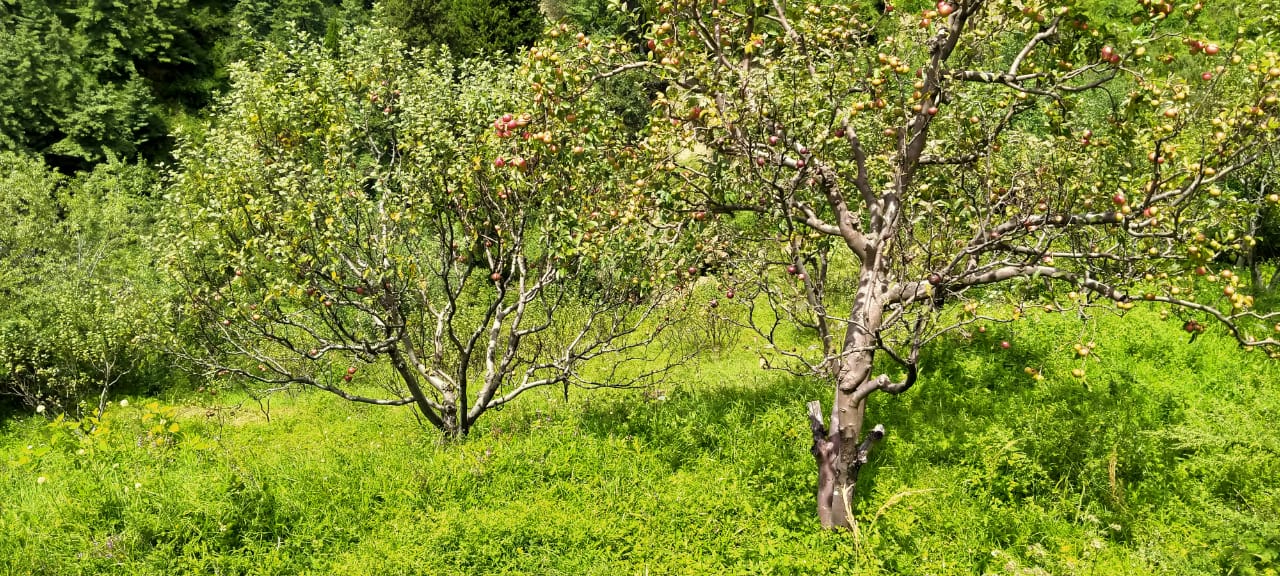
Photo: Apple orchard in Lower Mustang: Khanti Village
These phenomena or illustrations lead me to relate them to the growing impacts of climate change in my place. Many villages and cities across the world are witnessing similar changes and suffering differently. Climatic hazards vary with topography. Mountains and ice-lands area are facing rapid ice and snow melting triggering Glacier Lakes Outburst Floods and sea-level rise. Coastal areas are hit by cyclones, hurricanes and sea-level rise. Landslides and flash floods are common in hills and the plains. Vulnerabilities to climatic hazards on a specific location depending on multiple factors and mainly livelihood base, ecological diversity, population and level of preparedness. Climate change is a common global problem but climatic hazards and their vulnerabilities are localized and vary with locations. So, we need local solutions to the problems of climate change.
Nepal is developing policies and plans to address climate change. National Adaptation Programme of Action (NAPA), Local Adaptation Plan for Action (LAPA), National Climate Change Policy and Nationally Determined Contributions (NDCs) are some of the key policy documents. These documents contain many good provisions that aim to build community resilience to climate change impacts. However, these policies are not rolled out fully and honestly. One of the main reasons behind their non-implementation is they are not localized yet. To begin with, localization calls for their contextualization and their integration into local government level planning and programming, effective implementation, monitoring changes, and building on experience and learning. Ironically, however, many local governments are not even familiar with these policies not to talk of their roles in addressing climate change and any initiative from their side. Localized climate actions would pave the way for identifying and applying effective and sustainable climate solutions protecting places like Mustang from falling victim to climate change, and complement the fulfillment of the country’s national and international commitments on climate change.
Having said all this, I again feel like thinking about my own place, first. I am pinning my hope on the local government in my area (Mustang) would awaken to the urgency of taking action, and together with citizens like me and others start the process of localizing the existing policies and help Mustang to return to the Mustang of my childhood. Together, we might generate a “Mustang model”!!
MDB investment can support climate-resilient COVID-19 recovery in developing countries
Authors: Deborah Murphy, IISD and Prabin Man Singh, PRC
The 2019 coronavirus disease (COVID-19) pandemic has resulted in disruptions to and a weakening of the global economy in 2020. This health crisis and its economic impacts have demanded the attention, management and resources of both Multilateral Development Banks (MDBs) and developing country governments. The NAP Global Network reports adaptation to climate change may not be a priority in the short term for some governments and mobilizing resources for adaptation may be challenging as governments grapple with the added expense of COVID-19 responses, revenue loss and increased debt.
While MDB and developing country government attention on adaptation finance may have taken a backseat to COVID-19 responses in 2020, it is critical that economic recovery programs incorporate adaptation and climate resilience. The impacts of climate change are increasingly evident. The five-year period from 2016 to 2020 is expected to be the warmest on record, contributing to such impacts as disappearing Arctic ice, rising oceans, and more droughts and floods. In Nepal, extreme rainfall in 2020 caused 445 flooding and landslide incidents that claimed about 430 lives and displaced more than 5,000 people. This flooding, combined with the COVID-19 pandemic that has infected over 185,0000 people and claimed more than 1,000 lives in Nepal as of early November 2020, has severely disrupted economic activity. Economic recovery programmes for Nepal require additional financing from both domestic and international sources.
MDBs are at the forefront of addressing the challenge of the pandemic in many developing countries, and have committed hundreds of billions of dollars in loans and grants to first help tackle the health emergency and then move toward stimulus measures for economic recovery. In Nepal, the Asian Development Bank has provided grant funds of US$ 3 million for COVID-19 emergency response and a US$ 250 million concessional loan that is focused on social protection for the poor and vulnerable and economic support especially for affected small businesses. The World Bank has provided a concessional loan of US$ 29 million for COVID-19 emergency response and a grant of US$ 10.85 million for a school sector response to COVID-19. In addition, the World Bank has approved almost US$1 billion in concessional loans in 2020 to sectors that are critical to an effective COVID-19 economic recovery, including agriculture, urban development, energy, trade, forestry and strengthened financial sector stability.
A key lesson emerging from our research project, “Mobilizing Development Finance for Adaptation” is that adaptation must remain at the forefront in MDB and developing country government planning and programming. The Prakriti Resources Centre is working with the International Institute for Sustainable Development (IISD) to examine opportunities to scale up financing for adaptation from the perspective of developing countries and MDBs. The African Centre for Technology Studies (ACTS) in Kenya and Libelula in Peru are also research partners of this project that is funded by Canada’s International Development Research Centre (IDRC).
Our preliminary research tells us that sustainable recovery to the COVID-19 pandemic means that investment decisions taken today need to incorporate a longer-term perspective that promotes infrastructure, urban, and agricultural systems that are climate resilient. Additionally, crisis response needs to stress the importance of access to the environmental determinants of health – including water and sanitation, and nutritious food – and addressing the expected impact of climate change on these sectors. In the short term, this includes ensuring that MDB investment in COVID-19 recovery accounts for adaptation priorities; as well as highlighting the contribution that adaptation finance can make toward national social and economic development goals.
Raju Pandit Chhetri, Executive Director of PRC, highlighted the linkages between Nepal’s COVID-19 recovery response, the country’s emerging adaptation priorities, and World Bank programming. He remarked that, “The World Bank is supporting Nepal to develop an adaptation investment plan. It is critical that this plan be linked to and support national processes to develop Nepal’s National Adaptation Plan and to update the country’s Nationally Determined Contribution (NDC).” Chhetri further explained that the updating of the NDC and development of the NAP offers opportunity to guide adaptation action in the country’s pandemic response. But a critical factor in scaling up MDB support for adaptation is that the request that come from developing country governments. Government officials responsible for adaptation need to be engaged in discussions with MDBs; and MDB officials need to learn from and draw on country-led adaptation processes to identify priority actions.
While adaptation may appear to less of a priority during the COVID-19 pandemic, the climate emergency is not diminishing. MDBs and the Government of Nepal can work together to factor climate adaptation needs in COVID-19 recovery investments that promote inclusive, climate-resilient and sustainable systems and communities that encourage economic and social development.
Climate Concerns
United Nations Climate Change Conference (COP23) was held in Bonn, Germany in November. It was presided by Fiji—a small island developing state from Pacific region for the first time in the history of United Nations Framework Convention on Climate Change (UNFCCC). Hence, this Conference of Parties (COP) was also popularly dubbed as the ‘Pacific COP’.
COP23 was designed to be more a technical and process-oriented COP, as it needed to assist in the drafting of the ‘rule book’ for the implementation of Paris Agreement by 2018. However, expectations were also high as a highly climate vulnerable island country was chairing the meeting. The conference started with several references to the recent extreme events such as flooding in South Asia, hurricanes in the Caribbean and prolonged droughts in East Africa that had taken a huge toll on human life and property. This climate-induced evidence was highlighted with the aim to raise ambition and fulfill the expectations for the poor and vulnerable countries in tackling climate change.
Crucial times
The Bonn climate talks took place at a time when the United States, the world’s second-largest greenhouse gas (GHG) emitter with biggest historical responsibility, had decided to leave the Paris Agreement. Till date, 170 countries have ratified Paris Agreement and are committed to tackling climate change. With the US opting out, there is uncertainty on how the climate mitigation targets and the finance needed to address climate actions in the developing countries can be met. Many developing countries are worried that US may not do its bit in climate actions and provide finance to Green Climate Fund (GCF). Other developed countries like Canada, Norway and the European Union are also nervous that they might be pressured to take on additional burden after US withdrawal.
Climate finance was one of the major sticking issues at COP but was largely limited to procedural matters and no significant decisions were made. The developed countries mostly reiterated their commitments made in 2009 to jointly mobilize US$100 billion per year by 2020 in the form of long-term finance. The developing countries fought tooth and nail to secure the future of the Adaptation Fund. Currently, this international climate Fund established in 2001 to support adaptation actions in the developing countries sits under Kyoto Protocol. As a token relief, some developed countries including Germany and Sweden pledged around US$93 million into Adaptation Fund and US$92 million to Least Developed Countries Fund. These pledges provided some respite to the empty baskets that were established to support the poor and climate vulnerable countries.
Another major expectation from the Fiji Presidency was the advancement of loss and damage agenda that has been put to low profile for long. This issue is associated with permanent, irrecoverable and long-term effects caused by extreme events due to climate change. Small island countries have been championing this issue at the climate talks. However, when Fiji was presiding the meeting, Association of Small Island Developing States could not hang on to it for long. Additional finance sought to address this issue was ignored by the developed countries. The discussion was procrastinated to another round of ‘expert dialogue’.
In Bonn, one of the major symbolic wins for developing countries was pressuring the developed countries to agree on a process to review and enhance pre-2020 actions over the next two years. This was possible through leadership of China. Pre-2020 actions bind the developed countries to reduce their GHG emissions and provide finance to the developing countries. COP23 also set a path to a crucial process for 2018 called the ‘Facilitative Dialogue’ that was agreed two years ago in Paris. Fiji presidency renamed the expression ‘Facilitative Dialogue’ to ‘Talanoa Dialogue’, which is the Pacific concept for inclusive, transparent and constructive debate. Talanoa dialogue will hold series of discussions and assess whether the current climate mitigation action is in line with keeping the global average temperature rise to well below 2°C and to pursue efforts to limit the temperature increase to 1.5°C above pre-industrial levels. This dialogue will also be informed by the Special Report of the Intergovernmental Panel on Climate Change (IPCC) on global warming of 1.5°C that will be released in October 2018. The result of the dialogue is expected to feed into the climate ambition of Nationally Determined Contributions (NDC) that countries have to submit to UNFCCC every five years.
As an important achievement for the Fiji Presidency, it successfully declared the ‘Fiji Momentum for Ambition’ comprising of three elements—pre-2020 implementation and ambition, Talanoa dialogue and Completion of the work programme under the Paris Agreement. These elements should assist in raising the climate ambition and implementing the Paris Agreement.
Mixed reactions
After the conference ended, many developing countries had a mixed reaction to the final outcome. With no major announcements on climate finance and lack of predictability, transparency and accountability in the long term finance, developing countries especially the poor and most vulnerable countries found it extremely hard to find success in this COP. The issue of loss and damage was almost sidelined at this island COP. The presence of German Chancellor, Angela Merkel or French President Emmanuel Macron could not stir much optimism among the poor vulnerable developing countries.
Climate negotiators will have a busy year of 2018 in advancing the ‘Fiji Momentum for Ambition’ that will determine the successful writing of the Paris Agreement ‘rule book’ by COP24 in Poland next year. Paris Agreement was more of a political agreement but the technocrats will have to put this into action through a clearly defined stringent ‘rule book’. Failing to do so by the end of next year means Paris Agreement will end up in a bad destiny. This would be disastrous for both humanity and ecology. Underdeveloped and highly vulnerable countries like Nepal will be the first to suffer the most.
The author is the executive director of Prakriti Resources Centre. He attended COP23 held in Bonn, Germany.
@rajupchhetri
Original post: My Republica

